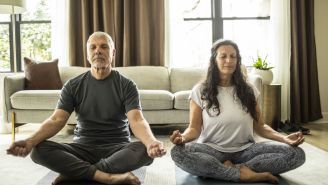When it comes to relaxing exercises that are easy on the joints and can be done anywhere, tai chi often comes to mind. The traditional Chinese practice has been found to improve balance, help reduce pain, and boost mental well-being. It may also enhance quality of life for people with chronic conditions, including heart failure, various cancers, stroke, fibromyalgia, and back pain.
Tai chi and other mind-body exercises may provide some benefits for your brain health, as well. In one December 2018 meta-analysis published in The Journal of the American Geriatrics Society, researchers looked at 32 randomized control trials involving more than 3,600 older adults with and without cognitive impairment. They found that mind-body exercises such as tai chi and Pilates helped improve participants’ memory, word retrieval, cognitive flexibility, and ability to process and understand information.
Despite the health benefits, though, learning the practice can be time consuming, with some disciplines consisting of up to 108 different moves. A newer variation of tai chi, called tai chi chih, is just as calming but much simpler to learn, making it an ideal activity for those interested in a non-vigorous strength exercise.
What is tai chi chih?
Tai chi is a combination of movement, concentration, and controlled breathing. Rooted in martial arts, it can take a while to learn, requiring between 30 and 36 class hours to master the basic moves.
Tai chi chih, on the other hand, is simpler. It was developed in 1974 by Justin Stone, a practitioner and teacher of tai chi. Stone wanted to create a smaller set of movements that retained many of the health benefits of tai chi, according to Michelle P. Carlino, E-RYT 500 YACEP and certified Tai Chi Chih instructor with Lourdes Health System.
His creation, tai chi chih, is made up of 19 movements and one pose. The moves are not related to martial arts and are designed to be learned in about eight classes. Carlino notes, however, that you can pick up many of the movements in your first class.
“You'll repeat a movement, 3, 6, 9, or 18 times—everything is in a multiple of three,” she says. “It's also called a moving meditation.”
The practice can be done anywhere, both indoors and outdoors, using only about 2 to 3 feet of space. It can be performed sitting or standing, making it an accessible form of exercise for people of various ages and abilities. The entire sequence of tai chi chih movements takes about 20 minutes to complete, but each movement can also be done on its own.
“If you don't have time to do the whole sequence, you can take five minutes in your day and just do one or two of the movements,” says Carlino.
Benefits of tai chi chih
So far there has been very little research on the benefits of tai chi chih specifically, but studies looking at tai chi—which can have many different styles and variations—are plentiful. For example, one 2016 review of tai chi research published in the British Journal of Sports Medicine found that it could be safely performed by middle-aged and older people undergoing treatment for cancer, osteoarthritis, heart failure, and COPD. It improved study participants' physical performance, and also reduced pain and stiffness in those with osteoarthritis.
Anecdotally, students of the practice describe many physical and emotional benefits. Carlino has seen health improvements among her own students, including less pain from arthritis and tendinitis, better sleep quality, and a decrease in stress. “The repetitive movement gives the mind a place to land, which becomes your focus, and that calms the brain,” Carlino says.
Many hospitals are beginning to hold classes as an alternative therapy used in conjunction with traditional medical practices. Because the exercises are gentle and can be perform seated, it may be safe for people with mobility problems or other physical limitations.
Carlino has clients of all ages and abilities. She teaches the movements to young adults battling anxiety and depression, as well as senior citizens looking to improve balance and reduce falls.
“I work with people in wheelchairs,” Carlino says. “I do this practice with people who are blind and others who are brain injured. It's very adaptable for any person.”
How to get started
First, speak with your healthcare provider before beginning any exercise program. If you’re interested in taking a class or learning more about the practice, a list of accredited instructors around the country is updated at taichichih.org. Local hospitals, community centers, and yoga studios may host classes, as well.
While there are videos on YouTube that may help you learn the process, Carlino says the best way to experience tai chi chih for the first time is to attend a class. Through in-person instruction, beginners can best learn the moves and get the most benefit out of the exercise.
“It's just a simple practice that can be learned very quickly and can improve your health on all levels,” Carlino says. “That's all you have to do: Just show up and you'll feel something in your first class.”







